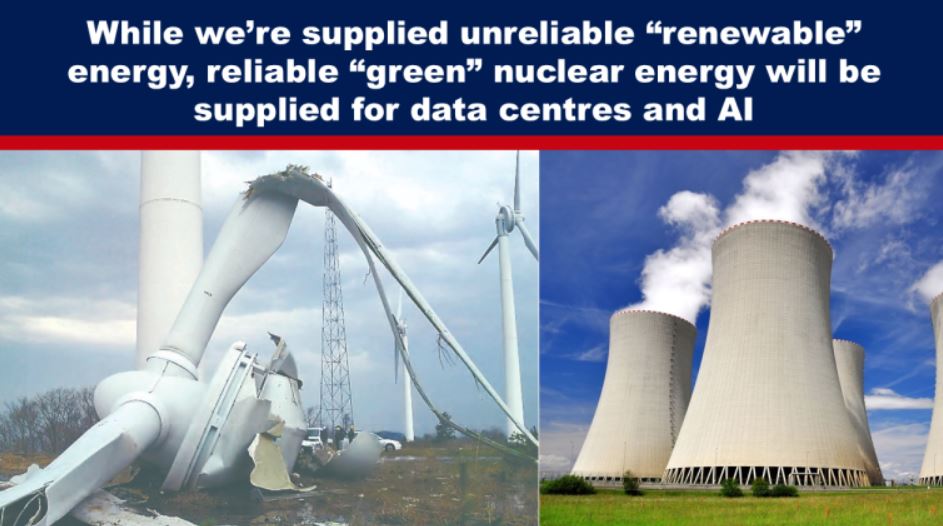AI systems require significant amounts of power to operate, driven by the massive computational resources needed to process and analyse vast amounts of data.
So, will the owners and advocates of AI systems rely on “renewable” wind and solar energy as they expect us to?
No. They are going to use nuclear power.
Why Does AI Require Significant Power?
AI’s insatiable need for power is driven by the complexity and scale of its computational requirements.
AI models are often trained and deployed in data centres, which are massive facilities housing thousands of servers. These servers consume a substantial amount of energy, equivalent to that of 30,000 homes.
AI inference, the process of answering user queries, relies heavily on Graphics Processing Units (“GPUs”). Each inference requires GPU processing power, which uses energy. This demand is expected to increase as more AI models are developed and deployed.
Larger AI models, such as those used in language processing and computer vision, require more computational resources and, consequently, more energy. These models have billions of parameters and rely on massive data sets, further straining energy demands. And as AI adoption grows, so does the need for more powerful infrastructure to support it.
In an own goal for those eager to implement Agenda 2030 and its Sustainable Development Goals – such as those who eagerly signed the ‘Pact for the Future’, ‘Global Digital Compact’ and ‘Pact for Future Generations’ at the UN Summit of the Future on Sunday – the energy consumption of AI systems contributes to greenhouse gas emissions, so they say, and strains global grids.
In Bloomberg’s podcast below (audio only) published on Tuesday, host David Gura and Bloomberg reporter Josh Saul discuss just what the insatiable AI data centre power needs mean for local communities, energy prices and efforts to switch to “renewables” to combat climate change.
“The big tech companies have set ambitious impressive clean energy goals … almost to a company [they] have said, ‘By 2030 we’re going to be 100% clean energy for our data centres’. But it’s a difficult thing to do because data centres are on all the time, 100% of the time, so to match that to clean energy is hard,” Saul said.
We guess matching large energy requirements 100% of the time is hard to do with “renewable” energy, i.e. wind and solar, because it is unreliable and intermittent.
However, the solution is simple; label nuclear energy as “green” energy. Gura posed the question: “Do they, the tech companies, believe that kind of traditional green energy, do they think that green energy is going to be enough to make up the difference that they need?”
Saul responded, “Well everybody loves nuclear I mean nuclear has gotten so hot, like Joe Rogan talking about nuclear.”
Gura chipped in, “Bill Gates is talking about it now.”
“Everybody. Yeah, everyone’s very excited about nuclear,” Saul said.
Governments Declare Nuclear as “Green” Energy
Although nuclear energy in the UK has been reducing, the UK government has for a long time actively promoted nuclear energy as a key component of its “green” energy strategy. An article published in the House of Lords Library ahead of a debate in 2021 stated:
The Government has said that new nuclear power is an important part of meeting its carbon reduction target. While the Government emphasises its commitment to renewable energy generation, it argues that ensuring the energy system is reliable means “intermittent renewables need to be complemented by technologies which provide power or reduce demand, when the wind is not blowing, or the sun does not shine.”
One of these technologies, says the Government, is nuclear power. “Delivering new and advanced nuclear power” was the third of ten points listed in the Government’s Ten Point Plan for a Green Industrial Revolution, published in November 2020 and reiterated in the Government’s December 2020 energy white paper. The white paper listed offshore wind, nuclear power and hydrogen as key to decarbonising the country’s energy system.
Nuclear power in the UK, House of Lords Library, 1 December 2021
In January 2024, the Conservative government announced plans to quadruple UK nuclear power by 2050, the largest expansion of nuclear energy in 70 years.
Further resources: Nuclear Power in the United Kingdom, World Nuclear Association, 21 May 2024
However, this is not the case in all countries.
In January 2022, while Germany was in the process of shutting down all its nuclear plants, the EU began planning to label energy from nuclear power and natural gas as “green” sources for investment, despite internal disagreement over whether they truly qualify as “sustainable” options.
The EU’s internal market commissioner Thierry Breton said the bloc will need to double its overall electricity production over the next three decades and that “is simply not possible without nuclear power.”
In April 2023, Germany shut down its last remaining nuclear power plant.
In August 2022, the US was divided over whether nuclear power is part of the “green” energy future. “The renewed interest in nuclear comes as companies, including one started by Microsoft founder Bill Gates, are developing smaller, cheaper reactors that could supplement the power grid in communities across the US,” NPR reported.
In April 2024, although Europe remains divided in its approach to nuclear power, delegations from more than 30 countries gathered in Brussels for the first-ever Nuclear Energy Summit. The summit followed an official call at COP28 in Dubai to accelerate nuclear energy alongside other low-carbon energy sources.
Meanwhile, particularly in the UK under the Labour government, unreliable, intermittent wind and solar are being pushed onto the public as their “green” future.
For examples of the “renewable” energy sources governments are pushing onto the public, you can read: ‘Ed Miliband: beating nimbys on green rollout a matter of ‘national security’’ for the UK and ‘Renewable energy’ from the European Environment Agency. There is no mention of nuclear power. Nuclear power is not being publicised as an option for the public. Why is that?
Restart of Nuclear Plant to Power Microsoft Data Centres
On Friday, Axios reported that Microsoft and Constellation Energy had just unveiled a power purchase deal that would enable a restart of a reactor at Pennsylvania’s Three Mile Island nuclear plant.
“The plan to bring a plant associated with an infamous 1979 partial meltdown back online in 2028 blends two big energy trends. One is the voracious energy needed to power data centres, especially as AI grows. The other is proposals to restart mothballed reactors, or delay closures, to meet rising electricity demand with zero-carbon sources,” Axios said.
The “two big energy trends” appear to be closely related and are mutually inclusive.
Technology companies are scouring the nation for power that is both reliable and helps them meet their pledge to fuel AI development with zero-emissions electricity – driving a nuclear power revival, according to The Washington Post.
“If approved by regulators, Three Mile Island would provide Microsoft with the energy equivalent it takes to power 800,000 homes,” The Washington Post said.
In a somewhat disingenuous statement, Microsoft’s Vice President of Energy Bobby Hollis said the deal is a “major milestone in Microsoft’s efforts to help decarbonise the grid in support of our commitment to become carbon negative.”
Constellation plans to invest $1.6 billion to revive the reactor. Constellation sees nuclear energy tax credits in the 2022 climate law as crucial for the project.
Banks Back Nuclear Power
On Monday it was announced that fourteen of the world’s largest banks and financial institutions have publicly pledged their support for the development of more nuclear energy, aiming to triple nuclear capacity by 2050, as outlined in the ‘Declaration to Triple Nuclear Energy by 2050’, signed by 25 nations at COP28. The Declaration refers to the Nuclear Energy Agency analysis which shows that a scenario where nuclear energy capacity is tripled by 2050 provides a feasible path to meet net zero, according to the Nuclear Energy Agency.
If nuclear energy provides a path to the much-touted “net zero,” why are governments pushing controversial “renewables” such as wind and solar onto the public? Perhaps “net zero” is a loose term that can mean whatever they want it to mean at any given time, depending on which part of the UN’s Agenda 2030 they are forcing onto the public.
The banks’ commitment to fund nuclear energy that was announced on Monday was made on the sidelines of Climate Week in New York City, where leaders from the global finance community, government representatives and industry executives gathered to discuss the role of nuclear energy in global decarbonisation efforts. Climate Week is an annual event held in partnership with the United Nations General Assembly.
To use Globalist speak, the support of these major financial institutions sends a strong market signal that nuclear energy is not only essential for decarbonisation but also a bankable, viable path forward for sustainable finance.
Why has nuclear, in particular, become so popular with financial institutions?
As Power Engineering noted, “Driven by decarbonisation goals and projected load growth from an artificial intelligence (AI) boom, support for nuclear power has especially increased the last couple of years … Technology giants like Microsoft, Google and Amazon are significantly driving electricity demand, primarily through extensive and rapidly expanding data centre operations. In doing so, they’ve expressed interest in nuclear as a partner.”
Environment and Energy Leader confirmed the same: “The demand for reliable, clean energy continues to grow, particularly in sectors like data centres and artificial intelligence (AI), where electricity consumption is skyrocketing.”
“James Schaefer, Senior Managing Director at Guggenheim Securities, emphasised this trend: ‘We’re seeing an enormous demand for clean electrons to power data centres and AI technologies. Nuclear energy is clean, proven and safe – and it’s essential that we accelerate the shift from planned projects to operational plants’.”
What’s Going On?
What this all seems to point to is that it will be largely unreliable and intermittent “renewable” wind and solar power for the public use but the vast amounts of reliable energy required for AI will be obtained from what has now been widely labelled as “green,” “clean” nuclear power.
Source: https://expose-news.com/2024/09/25/while-were-supplied-unreliable-renewable-energy/
Bitchute: https://www.bitchute.com/channel/YBM3rvf5ydDM/
Telegram: https://t.me/Hopegirl587
EMF Protection Products: www.ftwproject.com
QEG Clean Energy Academy: www.cleanenergyacademy.com
Forbidden Tech Book: www.forbiddentech.website













